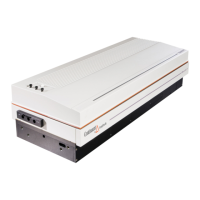Precision II Operation and Maintenance Manual C
5-10
996-0255 rev. b
NOT make direct electrical contact. The 4 kV signal is
inductively coupled onto the scope probe so close proxim-
ity is all that is required.
4) On the RB601 select PGM-3 mode and press ACTIVATE
and Q-SWITCH ON/OFF. The shutter should remain
closed and the Shutter LED should be off.
5) You should see on the scope a negative going pulse
several volts in amplitude occurring ~200 µs after scope
trace start.
6) If the trace is there but the timing is not ~200 µs adjust Q-
switch delay on RB601.
7) The presence of the trace indicates the three main electri-
cal components are all working properly and the system
should Q-switch. If there is no trace proceed to step 8.
8) Measure +15 V square wave 10µs wide pulse that comes
from the CU601C to the Marx board to trigger the ava-
lanche action. With scope still externally triggered and
PGM-3 still activated, unplug the small SMB connector
and measure signal on female center. If there is no signal,
perform continuity tests between SMB connector and the
CU601C. If OK, repair control unit.
9) With the system in the MANUAL mode, measure the 750
Vdc generated by the PC board located under the laser
bench. To do this, first power down the rack. Next dis-
connect the male HV BNC connector at bench surface.
Power up the rack and using a DVM measure the voltage
on the center female pin. It should read ~750 Vdc; if not,
adjust the voltage by using a pot “tweaker” to access the
adjust pot through hole in top of laser bench. If there is
no voltage replace the board.
10) If the 750 Vdc and the trigger pulse are there and still no
pulse is visible when you perform steps 1-5, then the
conclusion is that the Marx board has failed and it needs
to be replaced. Attempts to actively test the Marx board
are very difficult and are not recommended.
C. Going to free-running
The purpose of this section is to provide a detailed description on setting
up the oscillator to run in the free-running mode. It is important to follow
the procedures carefully. Any deviation from the listed procedures could
cause extreme optical damage.

